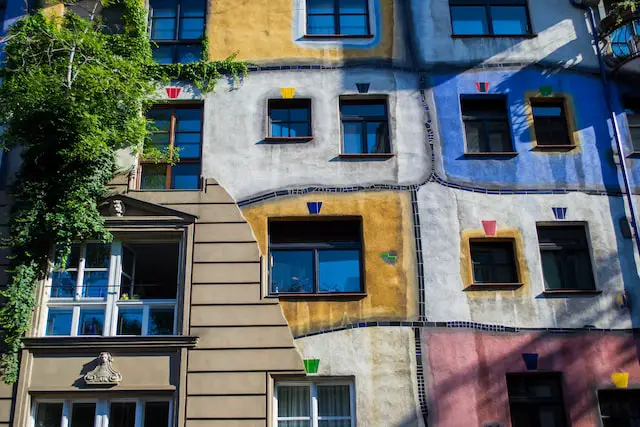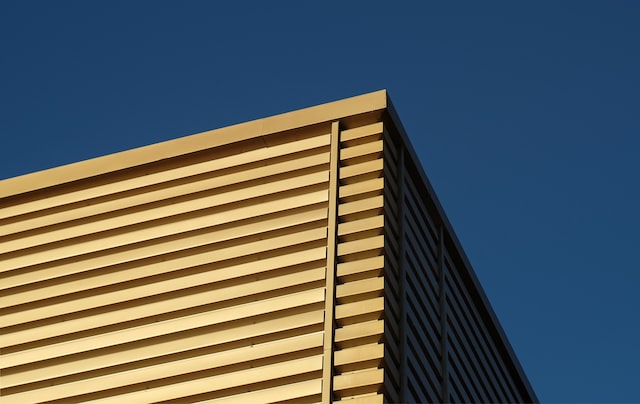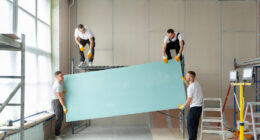A façade is the external face of a building, typically the front or main entrance, while cladding refers to the material used to cover the exterior walls of a building, such as brick, stone, or metal. Façade refers to the architectural design of the front of a building, cladding refers to the material used to cover the exterior walls.
What is a façade?
(Photo by Diogo Nunes on Unsplash )

A façade is the external face of a building, typically the front or main entrance. It is the architectural design of the front of a building, which can include elements such as windows, doors, and decorative features. The façade is often considered the most visible and important part of a building’s design, as it can greatly impact the overall aesthetic and perceived value of the structure.
The most common type of façade is the curtain wall, which is a non-structural outer cladding that is attached to the building’s structural frame. Curtain walls can be made from a variety of materials, including metal, glass, stone, or composite panels.
Another type of façade system is the rainscreen. Rainscreens are designed to protect the building envelope from water infiltration and wind damage. They are typically made from perforated metal panels or louvered vents that allow air and water to pass through while keeping out debris and pests.
What is cladding?
(Photo by Viktor Forgacs on Unsplash )

Cladding is a layer of material that is added to the exterior of a building. It can be used for both aesthetic and functional purposes. For example, cladding can be used to improve the thermal performance of a building, or to protect it from weathering.
There are many different types of cladding available on the market, including brick, stone, metal, glass and PVC. Each type has its own benefits and drawbacks, so it’s important to choose the right one for your project.
Metal cladding is a popular choice for modern buildings, as it offers a sleek and contemporary look. However, it can be expensive to install and maintain. Brick and stone cladding is more traditional, but it can be difficult to keep clean. Glass cladding is becoming increasingly popular, as it allows natural light into the building while still providing some insulation.
PVC cladding is a low-maintenance option that is growing in popularity. It is available in a range of colours and styles, making it easy to create an attractive façade. However, PVC cladding is not as durable as other options and may need to be replaced more often.
Façade Vs. Cladding – Key differences
The façade is the face of the building, the part that is most visible from the street or other vantage point. It is generally the showpiece of the building, designed to make a statement or create an impression. The façade may be made up of one material or a combination of several, and can be smooth or textured, plain or decorated.
Cladding is a layer that is applied to the outside of a building for protection or insulation. It can be made from a variety of materials including wood, metal, brick or stone. Cladding can be fixed directly to the structure of the building or attached using battens or another type of fixings.
In some cases, the cladding may also form part of the façade – for example, when it is used to create a decorative finish. However, it is more common for cladding to be used on parts of the building that are not immediately visible from ground level, such as the sides and rear.
What is the difference between façade and veneer?
There are two main types of external wall finishes: façade and veneer. Façade is a broad term that can refer to any type of external cladding, from brick to metal to glass. Veneer, on the other hand, is a thin layer of material applied over a substrate, typically for aesthetic purposes.
Facades can be either load-bearing or non-load-bearing. Load-bearing facades support the weight of the structure above them, while non-load-bearing facades do not. Veneers, on the other hand, are always non-load-bearing.
Facades can be either rainscreen or non-rainscreen. Rainscreen facades have an air gap between the cladding and the substrate, which allows water to drain and prevents it from penetrating the building envelope. Non-rainscreen facades do not have an air gap and are therefore more susceptible to water damage.
Veneers can be either real or simulated. Real veneers are made from thin slices of natural stone or wood that are glued or otherwise affixed to the substrate. Simulated veneers are made from man-made materials that mimic the look of natural stone or wood but are much cheaper and easier to install.
What is difference between wall cladding and wall Paneling?
Wall cladding is a material that is applied to the exterior of a building to protect it from the elements. Wall paneling is a decorative finish applied to the interior of a building. Both wall cladding and wall paneling can be used to improve the appearance of a building and to insulate it against heat and sound.
What is an example of cladding?
An example of cladding is a material that is used to cover the exterior of a building. This can be done for aesthetic or functional purposes. For instance, stone or brick cladding can give a building an elegant look, while metal cladding can provide better protection against the elements.
What is an example of façade?
A façade is an external wall of a building that serves as its primary face to the outside world. It is usually the most visible and decorative part of a building, and is often what people think of when they think of the word “building.” Facades can be made from a variety of materials, including brick, stone, glass, metal, or wood.
An example of a façade would be the front entrance to a large office building. This entrance would likely be very ornate, with columns and a detailed design. The rest of the building’s exterior walls would be considered cladding.
What are the different types of facades?
There are three main types of facades: Solid, Perforated, and Glazed.
Solid facades are the most common type of facade. They are typically made from brick, stone, or concrete, and they provide a high level of thermal mass, which helps to regulate indoor temperatures.
Perforated facades are less common than solid facades. They are typically made from metal panels that have been punched with small holes. The holes allow light and air to pass through the facade, while still providing some degree of privacy and protection from the elements.
Glazed facades are the least common type of facade. They are typically made from glass panels that have been treated with a special coating that allows them to reflect heat. Glazed facades can help to keep a building cool in hot climates and can also be used to create an eye-catching design feature.
What material is façade made of?
There are many materials that can be used for façade, including brick, stone, metal, glass, and wood. The most important factor to consider when choosing a material for your façade is how it will look in relation to the rest of the building. You also need to consider the maintenance requirements of the material and how it will age over time.
What are the different types of claddings?
The most common type of cladding is siding, which is made of wood, vinyl, or metal. Siding is easy to install and maintain, but it does not provide much insulation.
Another type of cladding is brick, which is more durable than siding but can be more expensive.
Stone cladding is also an option, but it is very heavy and requires professional installation.
Finally, there are composite materials that combine the best features of different types of claddings. Composite claddings are more expensive than other options but are also very durable and easy to maintain.
Why is cladding used on buildings?
Cladding is used on buildings for a variety of reasons, including to improve the appearance of the building, to protect the structure from the elements, and to insulate the building. Cladding can be made from a variety of materials, including stone, metal, brick, and glass.
What are exterior facades?
When it comes to the exterior of a building, the facade is the face that is seen first. It is the frontage or main entrance, and it usually sets the tone for the rest of the structure. The word “facade” comes from the Latin word facia, meaning “face.”
Cladding, on the other hand, is a layer that is applied to the outside of a building or object in order to protect it from the elements. It can be made from a variety of materials, including metal, stone, brick, glass, or wood. Cladding is often used to give a building an aesthetic appeal as well.
What is exterior wall cladding?
When it comes to the exterior of a building, the terms “façade” and “cladding” are often used interchangeably. However, there is a difference between the two: façades are the face of a building, while cladding is a material that is used to cover the outside of a structure.
Exterior wall cladding is a material that is used to cover the outside of a building. It is often used as an additional layer of protection against the elements, or for aesthetic purposes. Cladding can be made from a variety of materials, including wood, metal, brick, or vinyl.
What are cladding layers?
A cladding layer is a thin layer of material that is applied to the surface of a building as an exterior finish. Cladding materials can include brick, stone, metal, siding, stucco, and glass. The cladding layer is usually applied over a substrate of sheathing or structural panels.
The primary purpose of cladding is to protect the building from weather damage. Cladding also provides thermal insulation and soundproofing. In some cases, cladding can also improve the appearance of a building.
There are many different types of cladding materials available on the market, each with its own set of advantages and disadvantages. Some common cladding materials include brick, stone, metal, siding, stucco, and glass.
Brick is a popular choice for cladding because it is durable and low maintenance. However, brick can be expensive and difficult to install. Stone is another popular choice for cladding because it offers a natural look. However, stone is also expensive and difficult to install. Metal cladding offers a modern look and can be used to create unique designs. Metal cladding is also low maintenance but can be susceptible to corrosion over time.
Siding is a popular type of cladding because it is relatively inexpensive and easy to install. However, siding does not offer much protection against weather damage or fire. Stucco is another popular type of cladding because it offers a variety of textures and
Is rendering the same as cladding?
Rendering and cladding are not the same. Cladding is a layer of material that is applied to the outside of a building to protect it from the elements. Rendering is a coating that is applied to the outside of a building to improve its appearance.
What are the benefits of cladding?
- Increased Protection: Cladding can help to protect a building from the elements, as well as wear and tear.
- Improved Aesthetics: Cladding can give a building an updated and more polished look.
- Enhanced Insulation: Cladding can improve a building’s insulation, making it more energy-efficient.
- Greater Durability: Cladding can extend the life of a building by protecting it from the elements and wear and tear.
What are the benefits of façades?
- Aesthetics: Façades can greatly enhance the visual appeal of a building, making it more attractive and pleasing to the eye.
- Energy efficiency: Façades can be designed to optimize natural light and ventilation, reducing the need for artificial lighting and heating/cooling.
- Weather protection: Façades can protect the building and its occupants from the elements, such as rain, wind, and heat.
- Sound insulation: Façades can help to reduce noise pollution and improve acoustics inside the building.
- Durability: High-quality façades can be made from durable materials that can withstand the elements and resist wear and tear over time.
- Fire resistance: Façades can be designed to be fire-resistant, providing added safety for the building and its occupants.
- Green building: Some façade materials and technologies can contribute to the building’s sustainability and environmental performance.
- Cost efficiency: Façades can help to reduce costs associated with energy consumption and maintenance over time.
Featured Image By – Photo by Diogo Nunes on Unsplash








